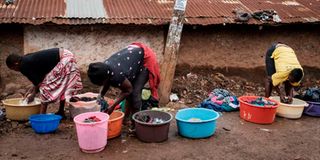Poverty eradication crucial to SDG success

Women wash clothes in Kibera slum in Nairobi on April 25, 2018.
What you need to know:
- Globally, poverty is concentrated in rural areas, where half those who live below the national poverty line are found; 35.5 per cent are in urban areas.
- Kenya’s commitment to end poverty by 2030 as one of the major goals of the SDGs should target those living in vulnerable environments.
Eradicating poverty in all its forms and lack of access to basic necessities such as food, clothing and shelter remains one of the greatest challenges for humanity.
The UN Sustainable Development Goals (SDGs) prioritise eradication of poverty, which remains one if the impediments to achievement of the rest. More than 700 million people, or 10 per cent of the world’s population, live in extreme poverty with most of them in South Asia and Sub-Saharan Africa. Many nations have since launched fast-track strategies towards that goal.
Some 1.9 billion people live in absolute poverty — a sharp increase from 836 million in 2015 — with 800 million living below the $1.25 (Sh125) a day poverty line, characterised by lack of food, clean drinking water and sanitation. In Africa, poverty is mostly realised by housing as increasing urban slums negatively affects the environment based on poor disposal of waste.
Bad politics
This, in most African countries, is due to bad politics, misplaced priorities, egocentrism and retrogressive plans that don’t match the rising human basic needs. In Kenya, slums are mushrooming in major towns and cities as an indicator of an inactive National Slum Upgrading and Prevention Policy (Sessional Paper 2of 2016).
Statistics show a decrease of poverty level from 46.8 per cent in 2007 to 45.2 per cent in 2014, but there is still a need to implement a robust mechanisms to further suppress it to at least 20 per cent. Kenya could be among African countries with good living standards, if not the top ones.
Globally, poverty is concentrated in rural areas, where half those who live below the national poverty line are found; 35.5 per cent are in urban areas. The government should invest more in rural areas to ensure farmers get better returns for produce.
Agriculture, in one way or the other, has sparked poverty. The backbone of the economy, it employing 60 per cent of the population and contributes half of the gross domestic product (GDP). Bad politics contributes to poverty in Kenya.
Politics of sycophancy
This include mainly the politics of sycophancy, whereby leaders appoint those who are less qualified in the agricultural ministries, leading to misplaced priorities in strategies of dealing with agricultural approaches of curbing poverty and wastage of agricultural products — as in the several cases at the National Cereals and Produce Board and inappropriate pest control, like the outbreak of the desert locusts in the country.
Kenya’s commitment to end poverty by 2030 as one of the major goals of the SDGs should target those living in vulnerable environments. This should include increasing their access to basic resources and services and supporting these communities affected by conflicts and climate change. There is a need to intensity usage of the National Social Safety Net Programme to improve their resilience.
Ologi Peter, Migori




